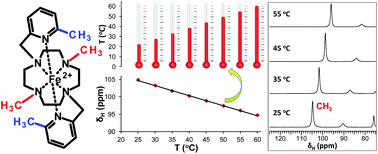当前位置:
X-MOL 学术
›
Dalton Trans.
›
论文详情
Our official English website, www.x-mol.net, welcomes your
feedback! (Note: you will need to create a separate account there.)
Fe(ii) and Co(ii) N-methylated CYCLEN complexes as paraSHIFT agents with large temperature dependent shifts†
Dalton Transactions ( IF 3.5 ) Pub Date : 2017-12-11 00:00:00 , DOI: 10.1039/c7dt03812g Pavel B. Tsitovich 1, 2, 3, 4, 5 , Timothy Y. Tittiris 1, 2, 3, 4, 5 , Jordan M. Cox 1, 2, 3, 4, 5 , Jason B. Benedict 1, 2, 3, 4, 5 , Janet R. Morrow 1, 2, 3, 4, 5
Dalton Transactions ( IF 3.5 ) Pub Date : 2017-12-11 00:00:00 , DOI: 10.1039/c7dt03812g Pavel B. Tsitovich 1, 2, 3, 4, 5 , Timothy Y. Tittiris 1, 2, 3, 4, 5 , Jordan M. Cox 1, 2, 3, 4, 5 , Jason B. Benedict 1, 2, 3, 4, 5 , Janet R. Morrow 1, 2, 3, 4, 5
Affiliation

|
Several complexes of Co(II) or Fe(II) with 1,4,7,10-tetraazacyclododecane (CYCLEN) appended with 1,7-(6-methyl)2-picolyl groups are studied as 1H NMR paraSHIFT agents (paramagnetic shift agents) for the registration of temperature. Two of the complexes, [Co(BMPC)]2+ and [Fe(BMPC)]2+, contain methyl groups only on the methyl picolyl pendents. Two other complexes, [Co(2MPC)]2+ and [Fe(2MPC)]2+, contain picolyl groups and also methyl groups on the macrocyclic amines. All macrocyclic complexes are in high spin form as shown by solution magnetic moments in the range of 5.0–5.9μBM and 5.3–5.8μBM for Co(II) and Fe(II) complexes, respectively. The 1H NMR spectra of both of the Fe(II) complexes and one of the Co(II) complexes are consistent with a predominant diastereomeric form in deuterium oxide solutions. The highly shifted methyl proton resonances for [Co(2MPC)]2+ appear at 164 and −113 ppm for macrocycle and pendent picolyl methyls and show temperature coefficients of −0.58 ppm °C−1 and 0.49 ppm °C−1, respectively. Fe(II) complexes have less shifted methyl proton resonances and smaller temperature coefficients. The 1H resonances of [Fe(2MPC)]2+ appear at 105 ppm and −46 ppm with corresponding temperature coefficients (CT) of −0.29 ppm °C−1 and 0.22 ppm °C−1, respectively. The relatively narrow linewidths of [Fe(2MPC)]2+, however, produce superior CT/FWHM values of 0.44 and 0.31 °C−1 for the N-methyl and picolyl proton resonances where FWHM is the full width at half maximum of the 1H resonance. The crystal structure of [Co(BMPC)]Cl2 shows a six-coordinate Co(II) bound to the macrocyclic amines and two pendent picolyl groups. The distorted trigonal prismatic geometry of the complex resembles that of an analogous complex containing four 6-methyl-2-picolyl groups, in which only two picolyl pendents are coordinated.
中文翻译:

Fe(ii)和Co(ii)N-甲基化CYCLEN配合物作为paraSHIFT剂,具有较大的温度依赖性位移†
研究了Co(II)或Fe(II)与1,4,7,10-四氮杂环十二烷(CYCLEN)附加了1,7-(6-甲基)2-甲基吡啶基的几种配合物,作为1 H NMR paraSHIFT剂(顺磁性移位剂)用于温度记录。两种配合物[Co(BMPC)] 2+和[Fe(BMPC)] 2+仅在甲基甲基吡啶基侧基上含有甲基。[Co(2MPC)] 2+和[Fe(2MPC)] 2+这两个其他配合物在大环胺上还含有甲基吡啶基和甲基。所有大环配合物是在高自旋形式如在5.0-5.9的范围内所示的解决方案的磁矩μ BM和5.3-5.8 μ BM分别用于Co(II)和Fe(II)配合物。Fe(II)配合物和Co(II)配合物之一的1 H NMR谱图与氘氧化溶液中的主要非对映异构体形式一致。[Co(2MPC)] 2+的高位移甲基质子共振出现在大环和悬垂的甲基吡啶甲基上,分别为164和-113 ppm,并且显示的温度系数分别为-0.58 ppm°C -1和0.49 ppm°C -1。Fe(II)配合物具有较少的移位的甲基质子共振和较小的温度系数。[Fe(2MPC)] 2+的1 H共振出现在105 ppm和-46 ppm时,相应的温度系数(CT)分别为-0.29 ppm°C -1和0.22 ppm°C -1。然而,[Fe(2MPC)] 2+的相对较窄的线宽对于N-甲基和甲基吡啶质子共振产生了更好的CT / FWHM值,分别为0.44和0.31°C -1,其中FWHM是半峰全宽。1 H共振。[Co(BMPC)] Cl 2的晶体结构显示六坐标的Co(II)结合到大环胺和两个悬垂的甲基吡啶基上。该配合物的扭曲的三角棱柱形几何形状类似于含有四个6-甲基-2-吡啶甲基的类似配合物的几何形状,其中仅两个吡啶甲基悬垂配位。
更新日期:2017-12-11
中文翻译:

Fe(ii)和Co(ii)N-甲基化CYCLEN配合物作为paraSHIFT剂,具有较大的温度依赖性位移†
研究了Co(II)或Fe(II)与1,4,7,10-四氮杂环十二烷(CYCLEN)附加了1,7-(6-甲基)2-甲基吡啶基的几种配合物,作为1 H NMR paraSHIFT剂(顺磁性移位剂)用于温度记录。两种配合物[Co(BMPC)] 2+和[Fe(BMPC)] 2+仅在甲基甲基吡啶基侧基上含有甲基。[Co(2MPC)] 2+和[Fe(2MPC)] 2+这两个其他配合物在大环胺上还含有甲基吡啶基和甲基。所有大环配合物是在高自旋形式如在5.0-5.9的范围内所示的解决方案的磁矩μ BM和5.3-5.8 μ BM分别用于Co(II)和Fe(II)配合物。Fe(II)配合物和Co(II)配合物之一的1 H NMR谱图与氘氧化溶液中的主要非对映异构体形式一致。[Co(2MPC)] 2+的高位移甲基质子共振出现在大环和悬垂的甲基吡啶甲基上,分别为164和-113 ppm,并且显示的温度系数分别为-0.58 ppm°C -1和0.49 ppm°C -1。Fe(II)配合物具有较少的移位的甲基质子共振和较小的温度系数。[Fe(2MPC)] 2+的1 H共振出现在105 ppm和-46 ppm时,相应的温度系数(CT)分别为-0.29 ppm°C -1和0.22 ppm°C -1。然而,[Fe(2MPC)] 2+的相对较窄的线宽对于N-甲基和甲基吡啶质子共振产生了更好的CT / FWHM值,分别为0.44和0.31°C -1,其中FWHM是半峰全宽。1 H共振。[Co(BMPC)] Cl 2的晶体结构显示六坐标的Co(II)结合到大环胺和两个悬垂的甲基吡啶基上。该配合物的扭曲的三角棱柱形几何形状类似于含有四个6-甲基-2-吡啶甲基的类似配合物的几何形状,其中仅两个吡啶甲基悬垂配位。











































 京公网安备 11010802027423号
京公网安备 11010802027423号